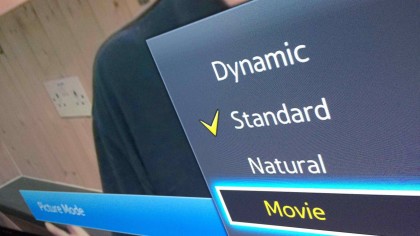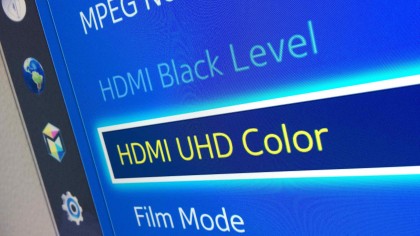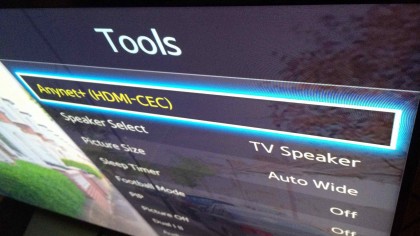Why you can trust TechRadar
I'm keen to find out if the UE48HU7500's relatively small screen – at least, in the era of Ultra HD 4K TVs – can truly offer enough extra detail beyond full HD to make it worth spending the extra money.
After all, Samsung makes a lot of stunning 48-inch Full HD TV that go for less than half the price of the UE48HU7500. However, how this set handles both regular HD and standard definition is equally as important as how it copes with 4K which, let's be honest, barely yet exists.
Ultra HD
Getting 2160p 4K content into the UE48HU7500 isn't easy, and that has to be an argument against investing in it in the first instance. However, with a USB stick containing a range of Ultra HD 4K video samples (in the HEVC-encoded MP4 format), I did manage to put the eight million pixels through their paces.
There's a catch here; technically the viewer needs to be no more than a metre away from the screen to notice the extra detail in 4K. Up close it's impossible to see the shrunken pixel grid – which is quite something, at first – but I didn't bother doing the review solely from a metre away. What's the point of that?

Retreating to about 2.5m there was a perceptible boost in detail visible in the compressed 4K MP4 video samples (I had no choice since the uncompressed 'pro-res' MOV file versions aren't supported by the UE48HU7500), but it depends what the footage is. During a short film about Taipei filmed to showcase Sony's F65 4K camera (and shot at 30fps) of some fireworks in Taipei, an overhead shot of the city is initially astonishing.
I could see every single car on the road individually despite there being hundreds on the screen simultaneously. Ditto a scene of a crowd counting down to New Year; every single crowd member was individually distinguishable, while the fireworks that followed were vibrant and so, so clear. There's some decent contrast against the night sky, too, though that fades quickly if you watch off-centre.
A 4K time-lapse sequence of the tourist crowds around Rome's Spanish Steps has even more clarity, underlining that 4K detail is especially evident during brightly-lit scenes with a lot going on; it's just more noticeable.
Sign up for breaking news, reviews, opinion, top tech deals, and more.
It's better than HD, sure, but is it four times better (since there are four times as many pixels packed-in to the panel when compared to a Full HD TV)? I'm not sure. These compressed files – though mostly immaculate – do feature a hint of picture noise and artefacts because they're compressed.

Since 4K is likely to primarily be streamed into a TV like the UE48HU7500 from the likes of Netflix, that's a worry. Take a 4K trailer for Elysium, as an example; its bright, slow-moving wide-shots of crowds and landscapes are stunningly detailed, but incidental shots and close-ups of actors are little more impressive than Full HD.
Compressed 4K? What an odd idea … though just when I'm beginning to pin my hopes on a future 4K Blu-ray disc, I come across Solar Rain of Fire, a short 4K film – again supplied as a compressed MP4 file – that offers a close-up of the Sun's bulging, bubbling surface. It's bright, it's lusciously coloured and it's the clearest, most involving 4K footage I've ever seen. 4K isn't always convincing on a 'small' screen like this, but it can be.
Black levels & contrast
A shot of a red Sun's explosive corona against the blackness of space reveals the UE48HU7500 to have a panel capable of some convincing black levels, too, though I'm not convinced about the set's Smart LED system. An ambient light detector that dims the brightness of the LED clusters along the edges of the panel, it didn't make any noticeable difference during the review.
The motion resolution is very decent, with fast-moving camera pans the clearest we've seen on a TV of this size. OK, so we're not talking a moving 4K image – no LED panel could offer that – but it's at least a Full HD image.

I found that engaging the set's frame interpolation tech was worthwhile, if only to give scrolling text a smoother look. Called Motion Plus, it's easy to overcook this blur/judder-busting tech if you head beyond the 'clear' strength. Any stronger and you'll notice the frequent side-effect of flicker around moving objects, though the more fluid image that results from the 'clear' setting is, I think, worth experimenting with.
High definition & 3D
The UE48HU7500's basic noise reduction options are worth toggling on since they do clean-up a touch of picture noise that appears around moving objects and graphics. Most impressively, there's barely a jagged edge in sight, which is some feat when you realise that for every single pixel in a Blu-ray disc, the UE48HU7500 has four pixels to fill.
While watching Gravity in 3D I was slightly disappointed to spot some judder during camera pans, though it's not a serious issue. I did try to cure this with the Motion Plus circuity, but it's not possible to do so without creating side-effects that are uncomfortable to watch. Otherwise, 3D looks sublime, with those edges staying coherent and the depth effects wowing – and no crosstalk in sight.
Standard definition
Rather shockingly, a blast of Pointless on BBC One on plain old standard definition looks clean and watchable. Not only is the TV frankly too big to expect that, but exactly how the UE48HU7500 fills-up all those extra pixels in such a convincing way is beyond me.

However, there is a little picture dirt that the UE48HU7500 built-in MPEG noise reduction option cleaned-up well enough. Later on in the evening on BBC One HD a HD broadcast of Not Going Out caused the UE48HU7500 no problems; not a jagged edge in sight. This 48-incher might not showcase 4K in all of its glory, but it's the perfect size to keep lesser sources looking good enough.
Current page: Picture quality
Prev Page Introduction and features Next Page Usability, sound and value
Jamie is a freelance tech, travel and space journalist based in the UK. He’s been writing regularly for Techradar since it was launched in 2008 and also writes regularly for Forbes, The Telegraph, the South China Morning Post, Sky & Telescope and the Sky At Night magazine as well as other Future titles T3, Digital Camera World, All About Space and Space.com. He also edits two of his own websites, TravGear.com and WhenIsTheNextEclipse.com that reflect his obsession with travel gear and solar eclipse travel. He is the author of A Stargazing Program For Beginners (Springer, 2015),
